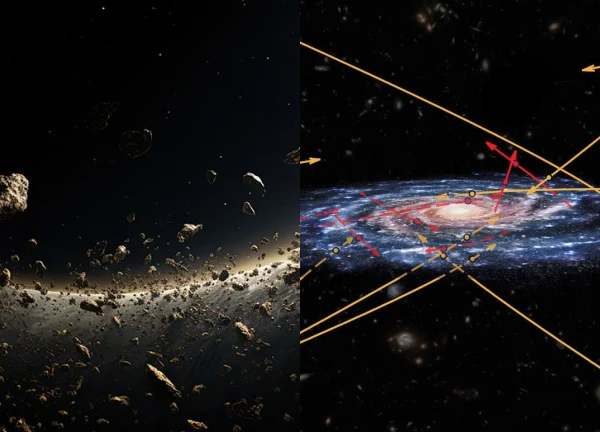Secrets of the universe: 55 stars fleeing, signaling an imminent galactic upheaval?

4 | 0 Discuss | Share
The Baja California Sur Peninsula is a strip of land that separates the Pacific Ocean from the Gulf of California located on the west coast of Mexico. The total area of the Baja California peninsula is 143,390 square kilometres (55,360 sq mi).
The peninsula is separated from mainland Mexico by the Gulf of California and Colorado River, and there are bridges over the Colorado River to reach the state of Sonora. There are four main desert areas in the peninsula: the San Felipe Desert, the Central Coast Desert, the VizcaÃno Desert, and the Magdalena Plain Desert.
According to Amusing Planet, on this peninsula, there is an extremely unique endemic tree. This species is found only on sandy soils, where it forms large populations. They "crawl" throughout the desert with a rather horror-looking appearance. It's crawling devil cacti.
The bull devil (Stenocereus eruca) is a unique cactus that grows on the Baja California Sur peninsula in Mexico's west coast, according to Amusing Planet. Instead of growing vertically like other species in the cactus family, the crawling devil is horizontal on the ground, with only the tops slightly raised. When hundreds of crawling devil stumps grow close together forming a large ensemble, the scene is like someone has cut down a tree into pieces.
The cow demon lies prostrate on the ground because this plant has an extremely rare crawling ability. The plant grows horizontally at the head while segmenting the tail on its own. The underside of the root of the new root at the elongated end helps the plant stick to the soil, as well as absorb water and nutrients as it slowly crawls across the desert surface. The tail decomposes and merges into the soil, turning into nutrients supplied to the plant through the roots.
The speed of development and movement of the bull devil depends on the climate in which the plant grows. In a normal climate, this succulent can grow an additional 0.6 cm per year, if their spiny stems gather together, it will turn into an impassable patch of land.
In hot and dry climates, the growth rate of this cactus will decrease to only 0.6 cm longer every 10 years. If in an ideal natural environment, not destroyed, caterpillar cacti can live up to a hundred years.
This cactus is able to survive freely on its own. Specifically, they usually grow forward and self-destruct their hind body. The tail part of the plant when self-destructing assimilates with the soil, turning into nutrients that feed the plant. After removing this part, the underside of the front part will grow new roots so that the plant can absorb nutrients back.
According to Gibson and Nobel, 1986, bovine devil cacti are considered "the most extreme cases of asexual breeding in the cactus family." This means that due to the isolation and scarcity of pollinators, plants can replicate themselves. Just like that, the crawling demon cactus is constantly moving and crawling through the whole desert.
Alfredo Beltrán Morales, a researcher at the University of Baja California Sur, revealed that a Creeping Devil cactus stalk costs between $4,000 and $5,000 on the black market. Even so, the illegal trade is only part of the threats this type of cactus faces.
Because Creeping Devil stems grow on the ground, they can have a major impact on cattle breeding and block movement. For this reason, many farmers have cleared Creeping Devil cactus bushes for arable land. Despite having a rather special survival mechanism, Creeping Devil is facing extinction. Due to its rare nature, Creeping Devil is being exploited rampantly illegally.
In particular, due to its monstrous shape along with unique cow characteristics, many fans also associate Creeping Devil cacti with a fictional monster in the movie "dune" - sand worm.
In the film, the sand worm is the center of the desert ecosystem of the fictional planet Arrakis, the main setting of the film and the culture of its inhabitants, the Fremen people. Sand worms live underground and excrete a substance that becomes an extremely important medicine called incense, and the Fremen ride them like giant sand-filled freight trains. In the film's first captivating shot of a sand worm, a house-sized mouth with teeth sticks out of the sand to devour an entire platoon of soldiers.
In the movie Dune, the sand worm terrifies people with its large body and unexpected strength. They live hidden under the sand and are called up by the sound of drumming on the ground.
"Although in real life, none of the worms quite like the worm in Dune are still alive today, some of its characteristics or its form actually resemble some of the truly alien creatures we find on the planet. If a small number of people get to know those animals after watching Dune, I think that's amazing, because these things — real life — are wonderful and diverse," paleontologist Luke Parry said.

4 | 0 Discuss | Share

2 | 0 Discuss | Share

3 | 0 Discuss | Share

3 | 0 Discuss | Share

2 | 1 Discuss | Share

2 | 0 Discuss | Share

4 | 0 Discuss | Share

0 | 0 Discuss | Share

1 | 1 Discuss | Share

3 | 0 Discuss | Share

4 | 0 Discuss | Share

4 | 0 Discuss | Share
2 | 1 Discuss | Report